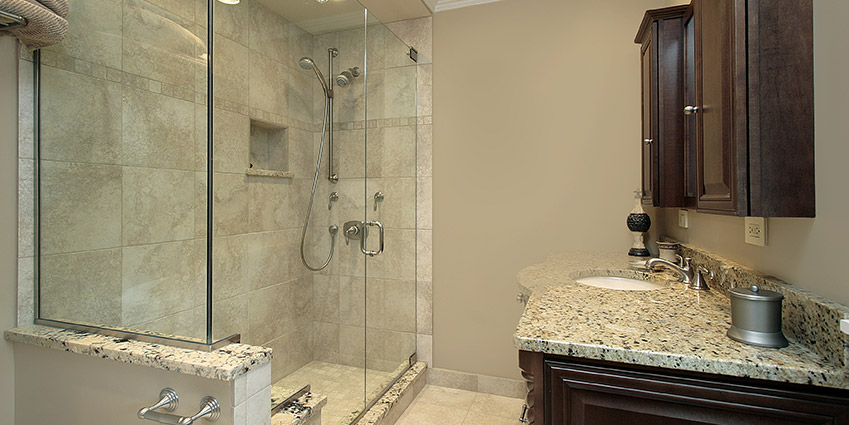Have you thought about remodeling your current restroom space in your basement? Or, are you thinking of installing a proper restroom? Some might wonder why a restroom in the basement is a worthy home improvement project. The fact is, the basement is one of the most under-utilized spaces inside of a house.
What’s The Purpose Of Your Basement?
The first thing you’ll need to do before you tackle your basement bathroom project is determine what you’re using your basement for. While it’s common for many home owners to use the basement as a throw-away place to store boxes and perform laundry duties, many other home owners have decided to take advantage of the plentiful space that’s available.
A basement’s square footage averages between 600-800 sq. ft. This is the size of an entire one bed room apartment! Think of all of the possibilities you could realize when you have this much space available. You could turn your basement space into a movie and entertainment area. You could create an adult lounge, complete with a wet and dry bar. Or, you can use the space as a pre-teen and teenager’s recreation room.
Why Place A Bathroom In The Basement?
Installing or remodeling a bathroom basement offers everyone a lot of convenience. This is especially true if you decide to turn the basement into guest quarters, or into a space studio that can be rented to tenants. The person living in a basement apartment will have access to their own facilities, without the need to come upstairs to use yours.
Why Remodel An Existing Basement Restroom?
Most basement restrooms are very depressing looking. They are small, and dark. The walls usually aren’t painted, and the sink is a stand-alone model that doesn’t allow for necessary counter usage. Therefore, remodeling your basement restroom will allow your guest to feel comfortable, while matching the décor of the bathroom to the décor of your renovated basement space.
If you’ve turned the basement into a studio apartment, you’ll need to remodel the basement with fixtures that allows your guests or tenants the ability to completely groom themselves.
Special Considerations For A Basement Bathroom: The Cons
While there are plenty of things that you can do to your basement and the restroom area, renovating the area does come with its unique set of challenges. First, the because the basement is below-level, it’s notorious for collecting moisture.
Before you install anything or begin any projects, you’ll need to ensure that your basement is professionally dried, and sealed. This involves contacting a contractor to create an irrigation system that allows groundwater to flow away from your house, instead of pooling underneath your home’s foundation. Then, the contractor will need to use professional blowers to air our your basement. The space will need to be disinfected of any mold and mildew that has developed, too.
Since your bathroom will be located in a small, dark, non-ventilated space, you’ll need to be mindful about the accumulation of increased moisture, and mildew. It’s best for you to install fixtures that are water-proof.
As you consider counter space in the bathroom, think about using a material that can’t develop mold and mildew, such as granite countertops. Granite is a solid slab of stone that can’t develop mold, especially after it’s been sealed. Granite countertops also add character, and charm. The material can easily be wiped down with soap and water. A 50/50 rubbing alcohol and water solution disinfects granite counters, when the need arises.
When you’re installing basement restroom fixtures, you shouldn’t have an issues with finding hot and cold water lines. Your biggest issue will be with the sewage drain lines. You’ll need to hire a plumber who is experienced at redirecting the flow of sewage upwards into the main sewage lines. Or, you can purchase bathroom pumps that move waste upwards into sewage lines that are already running through the upper levels of your house.
Finally, since the basement isn’t exposed to natural light, you’ll need to plan for the installation of lots of artificial light. However, once you adjust to the challenges of renovating a basement restroom, you’ll be very satisfied with the way that the final project looks.
Final Considerations
Make sure that you’re working with a contractor who specifically understands how to install basement bathroom fixtures. This advice especially applies to the installation of your granite countertops, if you decide to use granite. The contractor should also be aware of any pertinent permits involved in a basement restroom remodeling project.
Since the basement can be a tricky part of the home to begin a renovation project within, this isn’t a job for a friend. And certainly, granite is too heavy and precious of a product to allow a random person to handle, or install. When you’re ready to talk about your basement bathroom remodel, give us a call! We can even help with your flooring needs.
Next Up: Create A Perfect Vanity Centerpiece For Your Bathroom


